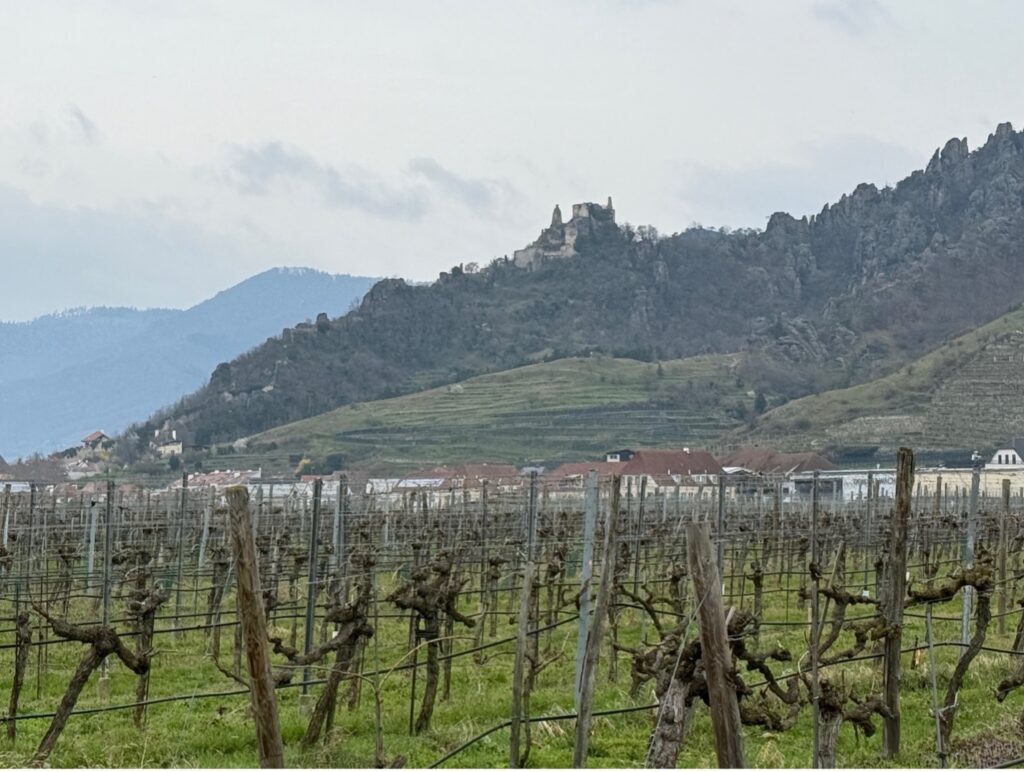
I remember when I first got into wine eons ago. I had just moved to San Francisco, so was only an hour and change from Napa and Sonoma. No surprise that I initially cut my teeth on California wine, which didn’t involve learning any classifications or Byzantine wine laws. The wines were also labeled by grape variety. But inevitably, European wines caught my attention, and then things got complicated. In some cases—like Germany and Italy—really complicated. At that point, I remember someone saying there were places in the wine world you would never truly know unless you went there.
I think it’s true. Nothing can replace going to a wine region. In fact, there are places like Burgundy, the Mosel, and Sherry where you’ll never know the wines until you actually talk to winemakers there, walk the vineyards, and taste bottles in situ. Only then will you be able to connect the dots. Then all the classifications, laws, and the wines will make sense—hopefully. One more thing. Certain wines can only be made in specific places. Mosel Riesling, Santorini Assyrtiko, and Savennières among them. Note the common theme of unoaked, high-acid, and mineral-driven white wines made from semi-aromatic grapes. Wines that also have a purity of fruit and are transparent in how they reflect the specific place where they are grown and made. I call wines like these pale fire. Austrian Grüner Veltliner and Riesling are just that.
Until recently, I’d never been to Austria. I’ve taught wine theory on the country for years, as well as tasted enough Grüner Veltliner, Riesling, and Blaufränkisch to be a huge fan. Then about a year ago, friend and MS colleague, Madeline Triffon, and I began to plan a trip to Austria. With the help of Jesse Becker, MS, and colleagues from Wines of Austria, we put together a week’s itinerary that included tastings at a dozen of the top producers. Finally, last month a group of seven of us spent five days touring and tasting in Niederösterreich and Burgenland. As wine trips go, it was as good as it gets. This post is part one of my thoughts and tasting notes from the week.
General thoughts
- We found the winemaking to be outstanding across the board.
- The fermentation vessels used were generally stainless steel or large neutral casks, the latter 300-500 liters.
- With the exception of one or two white wines, barriques were used for reds.
- The closure of choice: Often, lower-tier wines fermented in stainless steel were bottled with screwcaps. Those done in cask were bottled using cork.
- DIAM or other agglomerated corks are rarely used.
- Generally, the texture of the wines was superb—seamless and like glass. It speaks to the wines having spent six months or more on the lees but without batonnage.
- Polish filtration was common before bottling.
- The wines age well. At ten years, both Riesling and Grüner Veltliner from good vineyard sources are just hitting their stride.
Notes on Grüner Veltliner
Doing a deep dive on Grüner Veltliner was one of the major take aways from the trip. What was surprising was the broad range of styles: from lighter, citrusy, and high-acid bottlings with little of the herbal/vegetal character; to richer, more savory, and botrytis-influenced wines; and with everything in between. Here are points of commonality taken from the wines tasted.
- Generally, Grüner Veltliner is grown in heavier loess soils that retain more water.
- Broad expression of fruit: like Riesling, Grüner can show citrus (both tart and sweet), orchard fruit (apple/pear), tropical, and stone fruit—all in the same wine.
- Riper fruit results in more tropical and sweet citrus notes.
- Botrytis also results in tropical fruit as well as honey/honeysuckle, saffron, mushroom, etc.
- The herbal/vegetal notes make Grüner Veltliner unique. I call them botanicals: lime leaf, salad greens, celery, radish, daikon, lentil, parsley, and more.
- White pepper/rotundone is not universally found in Grüner Veltliner. I noted it in around 40% of the wines we tasted.
- Because the vines are grown on loess soils, the wines are both earthy and minerally as opposed to Riesling, which typically shows just mineral.
- The acidity of Grüner Veltliner is not as high as Riesling, and usually in the medium-plus range.
- The alcohol tends to be in the medium range with Smaragd wines higher.
- The wines often have phenolic bitterness due to brief skin contact, with Smaragd wines having higher levels.
- The wines need to get to 13% ABV to really show varietal character. Wines below 13% have less ripe fruit and not as many savory notes.
- Smaragd wines don’t necessarily have botrytis.
About the numbers
One of the things you’ll see in my tasting note for each wine below is a set of seven numbers. With that, I’ve never use the 100-point scoring system. I think it presupposes a precision and objectivity in wine that has never existed—and never will. Instead, I use a system developed over 25 years ago by good friend and fellow M.S., Peter Granoff, for his online wine retail company called Virtual Vineyards. To avoid using 100-point scores, Peter devised a system to convey the most important information about every wine that would appear in the Virtual Vineyards portfolio. His system used seven criteria to profile each wine: intensity of flavor, dryness/sweetness, body, acidity, tannin, oak, and complexity. Further, these seven criteria were represented in one-through-seven increments, with the number one representing least/none and the number seven the most or maximum.
For example, with dryness/sweetness, Peter’s chart lists bone dry at number one with dessert sweet at number seven. For intensity of flavor, the chart ranges from delicate at number one to intense at number seven. Note Peter’s deliberate decision not to use a 1-10 scale because it would be easy to extrapolate any number into a base 10 score, which he was trying to avoid. In sum, Peter’s chart looked something like this:
Intensity of flavor: Delicate 1 2 3 4 5 6 7 Intense
Dryness/sweetness: Bone dry 1 2 3 4 5 6 7 Dessert
Body: Light-bodied 1 2 3 4 5 6 7 Full-bodied
Acid: Light acidity 1 2 3 4 5 6 7 Tart acidity
Tannin: No tannin 1 2 3 4 5 6 7 High tannin
Oak: No oak 1 2 3 4 5 6 7 100% new oak
Complexity: Simple 1 2 3 4 5 6 7 Very complex
Notes on Grüner Veltliners tasted
With Peter’s wine profile system in mind, here are notes for some of my favorite Grüner Veltliners that we tasted during the trip.
Hirtzberger – Wachau
2024 Grüner Veltliner Spitz Federspiel (village wine), Wachau
Mandarin, white peach, Key lime, blossom, lentil, parsley, and mineral. The palate is rich and almost unctuous—and this is just a Steinfeder. Medium phenolics on the finish with more than enough acidity to balance.
5/1/5/5/1/1/5
2024 Grüner Veltliner Axpoint Smaragd, Wachau
Like lemon meringue pie with herbs, mineral, and light spice. The palate is sleek but ripe and full-bodied with citrus, mineral, and phenolic notes.
5/1/5/5/5/1/1/5
2024 Grüner Veltliner Honivogl Smaragd, Wachau
Ripe apricot, Meyer lemon, and pink grapefruit with pepper, celery, lentil, and earth. The richest wine of all but enough acidity to balance.
5/1/5/5/1/1/5
Emmerich Knoll – Wachau
2023 Grüner Veltliner Ried Trum Federspiel
Tart citrus and white peach with radish, leafy greens, and mineral. Vibrant and tart on the palate.
4+/1/4/5+/1/1/5
2023 Grüner Veltliner Ried Schütt
Green pear, white peach, and sweet/tart citrus with peach blossom, white pepper, botanicals, and earth. Full and vibrant with a long phenolic finish.
5/1/4+/5-6/1/1/5
2023 Grüner Veltliner Loibner Vinotekfüllung Smaragd
A blend of ripe/over ripe grapes from top sites. Honey, floral, sweet and tart citrus, yellow peach, celery, parsley, salad greens, and mineral. Dry but unctuous; Auslese trocken-like.
6/2/5/6/1/1/6
Rudi Pichler – Wachau
2023 Grüner Veltliner Terrassen Smaragd
Honey, citrus blossom, white peach, apricot, lime, celery, lentil, radish, and soil/mineral. Rich and dense on the palate but the finish turns tart with mineral and phenolic bitterness.
5/1/5/5/1/1/5
2023 Grüner Veltliner Smaragd Wösendorfer Kollmütz
Apricot, orange, and lime with white floral, pepper, lentil, and earth. Very peppery and savory with a pronounced earthy mid-palate and elevated acidity on the finish.
5/1/5/5/1/1/5
2023 Grüner Veltliner Smaragd Weissenkirchner Achleiten
The richest and most concentrated of the three 2023 single vineyard Smaragd wines. Stone and tropical fruit, sweet and tart citrus with green tea, pepper, lentil, and earth. Rich, dense, and focused on the palate. Very savory and long.
5/1/5/5/1/1/6
2016 Grüner Veltliner Smaragd Wösendorfer Kollmütz
Crystalized honey, orange marmalade, dried savory herbs, and mineral. Dense but not heavy. The palate is mineral-driven with vibrant acidity.
5/1/4/5/1/1/6
2013 Grüner Veltliner Smaragd Wösendorfer Kollmütz (from magnum)
Honey, orange marmalade, and candle wax with dried herbs and earth. Dense and rich but not heavy; long, persistent and very complex.
5/1/4/5/1/1/7
Brundlmayer – Kamptal
2023 Grüner Veltliner Berg Vogelsang
The vineyard is planted on silicate rock instead of loess. Floral, pepper, lime, white peach, leaf, lentil, radish, and mineral. Has the elevated acidity of Riesling because it’s planted on stony soil.
4/1/4/6/1/1/5
2015 Grüner Veltliner Ried Heiligenstein Erste Lage Alte Reben
Bergamot, dried floral, dried parsley, lentil, pepper, lime dust, and mineral. Seamless, layered, and complex with a long finish.
5/1/4/5/1/1/6
2012 Grüner Veltliner Ried Käferberg Erste Lage
Honey (botrytis?), pepper, dried parsley, lentil, veggie broth, and earth/mineral. Superb fruit-acid balance. Savory and mineral-driven.
5/1/4/5/1/1/6
Schloss Gobelsburg – Kamptal
2024 Grüner Veltliner Langenlois
The slightly warmer climate in the Kamptal results in richer wines. The 2024 Langenlois is effusive and aromatic on the nose with ripe peach/apricot, Meyer lemon, white pepper, green leaf, and earth. Broader, richer palate with mineral and ripe/tart fruit.
5/2/4/5+/1/1/5
2022 Grüner Veltliner Ried Lamm Erste Lage DAC
Fuji, green pear, white peach, and sweet citrus with honey, pepper, savory green notes, and mushroom. Very peppery and savory with earth and mineral in the midpalate and a surprisingly tart finish.
5/2/5/5/1/1/5+
2016 Grüner Veltliner Ried Renner, Erste Lage DAC
The fruit is evolved but still fresh with ripe apple/pear, citrus, and peach. Also green tea, pepper, leaf, and mushroom/soil. Seamless; like light through a cathedral rose window that keeps changing. Tart and phenolic finish. Fresh for its age.
5/1/4/5+/1/1/6
Look forward to more in Part 2 …
FOLLOW ME ON SOCIAL MEDIA FOR PICTURES FROM AUSTRIA
Learn more professional wine tasting strategies in my book,
Message in the Bottle: A Guide to Tasting Wine
